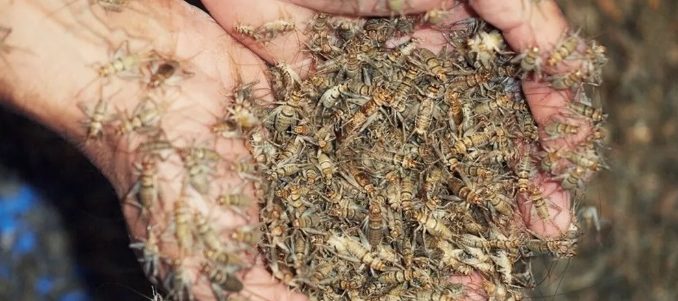
Handling Live Crickets With Care
The first thing you must absolutely know if you plan on raising your own crickets, may it be to feed reptiles, yourself or just to keep as pets, is that they are very fragile creatures. Those who already tried will tell you how difficult it can be to keep them alive long enough just in order to get back home from the store. Indeed, more often than not, most of them are dead either on arrival or soon after.
We recommend you find your own technique for this step, as you’ll have to repeat it every time you’ll need to clean your container.
What Kind of Container Should I Use?
Materials
Regarding the storage container, there is no specific recommendation about what kind of material to use, as long as it shows a smooth surface, so that the crickets can’t jump out of it: both plastic and glass are suitable.
Size
About the size, it is usually advised to count something like 1 gallon for 100 crickets. So a quantity of 1,000 crickets or more will need at least a 10-gallon container, and so on.
Aeration
If there isn’t any, you will also have to cut some holes in the tank so your little critters can get oxygen properly. Then tape the holes with a very thin wire nettling, at least thin enough for the crickets not to be able to go through it.
Avoid professional cricket keepers
Also, know that you can find specific cricket keepers at some exotic pet stores, but we don’t really recommend them, as they often come with tubes that the crickets can climb up in. It seems handy at first, but if the tank is too crowded, crickets at the end of a tube tend to get squashed, or lack oxygen, or else can’t get to their food or nutrition, and end up dying quickly. Even the largest keepers, which are supposed to be good for 200 crickets, are usually too crowded. They would be appropriate if you plan on breeding no more than a hundred healthy crickets; if you plan on raising more than that, you probably have better making your own DIY container.
What Environment Do They Need?
Crickets love dark spaces
One thing you have to be aware of while preparing your tank for taking care of live crickets is that they always seek out dark spaces. For that reason, you must essentially supply plenty of them so that they’re not all clamouring for the same little spaces. The best for that is to keep the egg crates that came in the shipping boxes, also because it will help them to recognise a part of their environment and survive the transition at best. You may also use toilet paper or paper towel rolls, or any other stuff they can tuck themselves in.
Temperature and dormant phase
Another thing you have to know is that crickets can endure heat quite well whereas they are more sensitive to colder temperatures. But be reassured if your winter crickets shipment appear lifeless: these fascinating little insects can go into a state of hibernation and become dormant, which means that once you allow them to warm up to room temperature for a couple hours, they usually perk right up. So don’t pass judgment on their condition to fast!
Once back on their feet, the ideal range of temperature for a proper functioning of your live crickets’ metabolism and immune system should be around 22°C (between 70° – 75° F). Also, avoid exposing them to direct sunlight, high humidity, or drafts of cold air as they are very sensitive to it.
Clean is healthy
We often say about humans that a clean and tidy environment is helping to keep a healthy body and spirit. Well this is also true about crickets (although we might leave the spirit side apart as we are not yet sure they do have one). It seems obvious to say that you must keep your cricket keeper clean at all times to ensure them a healthier and longer life. The most important is to keep your container free of all dead crickets and waste material.
Do not use chemicals!
While cleaning your little beasts’ tank, NEVER use pesticides or chemical cleaning solutions, as they are very sensitive to this too. Just use hot soapy water or VERY MILD bleach solution to rinse it, and make sure your container is well dried before putting the insects back in: crickets can drown in very little water!
What Should I Feed my Crickets?
Once their container and environment is ready and that your crickets are happily frolicking in it, keeping them alive doesn’t require much care. In order to survive, they just need some basic food and water in separate sources.
Food
Always feed your crickets on dry food, such as oatmeal or cornmeal. You may also find dry cricket food in some pet stores, such as chicken mash or chick starter. Remember to change the food as needed or weekly at most and always make sure not to get it damp or mouldy.
Water
Again, the same as humans, the quickest way to let crickets die is to leave them away from their water source; it is crucial you keep it available at all time. But again, also remember that crickets can drown very quickly, that is why we recommend using something as simple as a damp sponge sitting on a shallow plate rather than an open pool of water. However, do not forget to check it daily to make sure it is still damp.
You can also find “water bites” in specialised shops, some of them providing your little critters with a combination of both water and nutrients. You might have already seen these as it is usually used in crickets shipment boxes.
Sometimes, they are also sent with a chunk of potato: indeed, potatoes can serve as both water and food to crickets. However, do not use it as a daily food source as it can cause a dampening of the environment and create mould, which are both very harmful to your live crickets. If you do use potato, make sure it is not to often and that you don’t leave it for more than a couple of days.
Well, we hope you are now fully ready to breed your own live crickets and that they will live a very happy long life. We wish you the best of the best with your little insects!
How long do crickets live without food or water?
If you are keeping crickets for gecko of for a small reptile, you might be asking how long can cricket live without food or water. First of all, the first question we are going to answer is: how long do crickets live? In a normal way, the lifespan of crickets is 8-10 weeks once adults if they have enough food and water. If they just can’t have food or water, crickets can live 2 weeks more. Then, they will starve to death.

Leave a Reply